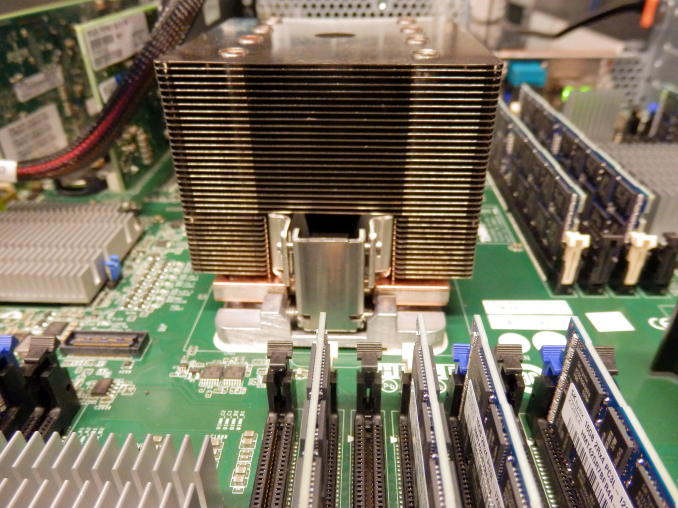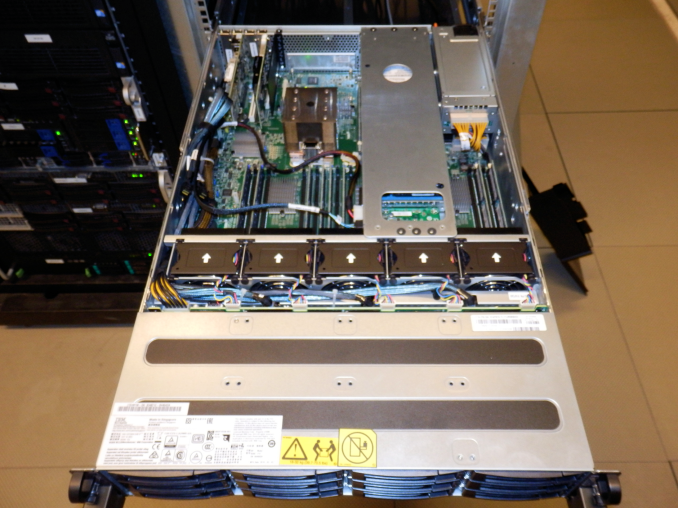Assessing IBM's POWER8, Part 1: A Low Level Look at Little Endian
by Johan De Gelas on July 21, 2016 8:45 AM EST
It is the widest superscalar processor on the market, one that can issue up to 10 instructions and sustain 8 per clock: IBM's POWER8. IBM's POWER CPUs have always captured the imagination of the hardware enthusiast; it is the Tyrannosaurus Rex, the M1 Abrams of the processor world. Still, despite a flood of benchmarks and reports, it is very hard to pinpoint how it compares to the best Intel CPUs in performance wise. We admit that our own first attempt did not fully demystify the POWER8 either, due to the fact that some immature LE Linux software components (OpenJDK, MySQL...) did not allow us to run our enterprise workloads.
Hence we're undertaking another attempt to understand what the strengths and weaknesses are of Intel's most potent challenger. And we have good reasons besides curiosity and geekiness: IBM has just recently launched the IBM S812LC, the most affordable IBM POWER based server ever. IBM advertises the S812LC with "Starting at $4,820". That is pretty amazing if you consider that this is not some basic 1U server, but a high expandable 2U server with 32 (!) DIMM slots, 14 disk bays, 4 PCIe Gen 3 slots, and 2 redundant power supplies.
Previous "scale out" models SL812 and SL822 were competitively priced too ... until you start populating the memory slots! The required CDIMMs cost no less than 4(!) times more than RDIMMs, which makes those servers very unattractive for the price conscious buyers that need lots of memory. The S812LC does not have that problem: it makes use of cheap DDR3 RDIMMs. And when you consider that the actual street prices are about 20-25% lower, you know that IBM is in Dell territory. There is more: servers from Inventec, Inspur, and Supermicro are being developed, so even more affordable POWER8 servers are on the way. A POWER8 server is thus quite affordable now, and it looks like the trend is set.
To that end, we decided that we want to more accurately measure how the POWER8 architecture compares to the latest Xeons. In this first article we are focusing on characterizing the microarchitecture and the "raw" integer performance. Although the POWER8 architecture has been around for 2 years now, we could not find any independent Little Endian benchmark data that allowed us to compare POWER8 processors with Intel's Xeon processors in a broad range of applications.
Notice our emphasis on "Little Endian". In our first review, we indeed tested on a relatively immature LE Ubuntu 14.04 for OpenPOWER. Some people felt that this was not fair as the POWER8 would do a lot better on top of a Big Endian operating system simply because of the software maturity. But the market says otherwise: if IBM does not want to be content with fighting Oracle in an ever shrinking high-end RISC market, they need to convince the hyper scalers and the thousands of smaller hosting companies. POWER8 Server will need to find a place inside their x86 dominated datacenters. A rich LE Linux software ecosystem is the key to open the door to those datacenters.
When it comes to taking another crack at our testing, we found out that running Ubuntu 15.10 (16.04 was just out yet when we started testing) solved a lot of the issues (OpenJDK, MySQL) that made our previous attempt at testing the POWER8 so hard and incomplete. Therefore we felt that despite 2 years of benchmarking on POWER8, an independent LE Linux-focused article could still add value.











124 Comments
View All Comments
zodiacfml - Thursday, July 21, 2016 - link
Like a good TV series, I can't wait for the next episode.aryonoco - Friday, July 22, 2016 - link
OK, this is literally why Anandtech is the best in the tech journalism industry.There is nowhere else on the net that you can find a head to head comparison between POWER and Xeon, and unless you work in the tech department of a Fortune 500 company, this information has just not been available, until now.
Johan, thank you for your work on this article. I did give you beef in your previous article about using LE Ubuntu but I concede your point. Very happy to you are writing more for Anandtech these days.
Xeons really need some competition. Whether that competition comes from POWER or ARM or Zen, I am happy to see some competition. IBM has big plans for POWER9. Hopefully this is just the start of things to come.
JohanAnandtech - Friday, July 22, 2016 - link
Thanks! it is very exciting to perform benchmarks that nobody has published yet :-).In hindsight, I have to admit that the first article contained too few benchmarks that really mattered for POWER8. Most of our usual testing and scripting did not work, and so after lot of tinkering, swearing and sweat I got some benchmarks working on this "exotic to me" platform. The contrast between what one would expect to see on POWER8 and me being proud of being able to somewhat "tame the beast" could not have been greater :-). In other words, there was a learning curve.
tipoo - Friday, July 22, 2016 - link
I found it very interesting as well and would certainly not mind seeing more from this space, like maybe Xeon Phi and SPARC M7jospoortvliet - Tuesday, July 26, 2016 - link
Amen. But, to not ask to much, just the prospect of part 2 of the Power benchmark is already super exciting. Yes, the Internetz need more of this!Daniel Egger - Friday, July 22, 2016 - link
Not quite sure what the Endianess of a systems adds to the competitive factor. Maybe someone could elaborate why it is so important to run a system in LE?ZeDestructor - Friday, July 22, 2016 - link
Not much, really, with the compilers being good and all that.Really, it's quite clearly there just for some excellent alliteration.
JohanAnandtech - Friday, July 22, 2016 - link
Basically LE reduces the barrier for an IBM server being integrated in x86 dominated datacenter.see https://www.ibm.com/developerworks/community/blogs...
Just a few reasons:
"Numerous clients, software partners, and IBM’s own software developers have told us that porting their software to Power becomes simpler if the Linux environment on Power supports little endian mode, more closely matching the environment provided by Linux on x86. This new level of support will *** lower the barrier to entry for porting Linux on x86 software to Linux on Power **."
"A system accelerator programmer (GPU or FPGA) who needs to share memory with applications running in the system processor must share data in an pre-determined endianness for correct application functionality."
Daniel Egger - Friday, July 22, 2016 - link
While correct in theory, this hasn't been a problem for the last 20 years. People are used to using BE on PPC/POWER, the software, the drivers and the infrastructure are very mature (as a matter of fact it was my job 15 years ago to make sure they are). PPC/POWER actually have configurable endianess so if someone wanted to go LE earlier it would have easily been possible but only few ever attempted that stunt; so why have the big disruption now?KAlmquist - Friday, July 22, 2016 - link
I assume that this is about selling POWER boxes to companies that currently run all x86 servers, and have a bunch of custom software that they might be willing to recompile. If the customer has to spend a bunch of time fixing endian dependencies in his software in order to get it to work on POWER, it will probably be less expensive for them to simply stick with x86.